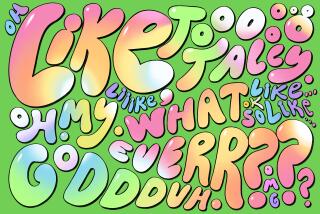U.S. Drifting Apart, in So Many Words
- Share via
Remember how television, that mighty social sledgehammer, was going to pulverize our language? Nothing would remain of our distinctive accents and dialects; we would all be bland, chattering like so many weather announcers.
It seems, however, in the event you haven’t been listening, that the contrary is happening.
Far from disappearing, those distinctive manners of speaking that vary from place to place and people to people are in profusion.
In fact, William Labov, professor of linguistics at the University of Pennsylvania, concludes that Americans talk less like one another today than they did when TV emerged half a century ago.
Yes, rural dialects are undergoing “gradual” weakening, and some regional vocabulary is disappearing. But Labov says there is “rapid development of new sound changes” in urban America, where most of us live.
*
“It appears that the dialects of our great cities are more different from each other now than they were 50 or 100 years ago,” Labov says.
“It isn’t that every city is going off in a different direction. But in one way or another, almost every city is seeing changes,” he says.
“And are these changes making it harder for people to understand each other? Yes.”
Labov is directing a research team that is assembling the first comprehensive and scientific maps of American pronunciation. His work is sponsored by the National Science Foundation and the National Endowment for the Humanities and relies on voice interviews with hundreds of Americans. Trained researchers and audio analysis by machine are used to distinguish dialects.
Most differences in dialect are subtle and difficult to convey concisely in print. But one example of an emerging city dialect is Philadelphia. Labov says residents increasingly are dropping their Ls in the middle of words. So a customer asking to buy New Balance shoes, says “New Ba-ance.” The wine cellar becomes “ce-ar.”
“It causes the most astonishing misunderstandings,” says Labov.
As might be expected, Labov’s findings have both supporters and critics.
A supporter is Guy Bailey, dean of liberal arts at the University of Nevada Las Vegas and a linguist specializing in Southern accents. Bailey’s research is just as surprising as Labov’s.
Bailey has studied audio recordings of Southerners who grew up in the mid-19th century and concludes that most of what we regard as the Dixie drawl arose after the Civil War, perhaps in reaction to Yankee Reconstruction. Today, the Southern drawl is becoming more distinctive in some regards, he says.
What is occurring in America, Bailey concludes, is “linguistic divergence.”
William Stewart, professor of linguistics at the graduate school of the City University of New York, disagrees entirely.
In a telephone interview, he says: “Listen. You and I are 2,500 miles apart. We were born an ocean apart--I’m from Hawaii. We talk just alike. Compare that to the days of the Continental Congress. Back then, if you could have walked the halls, you would have known precisely where delegates came from just by the way they talked.”
Stewart says dialects began to wane after World War I, when the middle class ballooned in size and America became a mobile nation. He says that today’s dialects are nothing but eddies in the inexorable current homogenizing American English. Moreover, Stewart says, the same trend is occurring in other nations. “All over the world there is a leveling of language,” he says.
Back to Labov: Quite the contrary, he argues. “Everywhere throughout the world language diversity is increasing.”
Labov grants critics “plenty of reasons” to assume our language is becoming homogeneous. But he says these scientists may be overlooking decade-by-decade changes so subtle that we are not aware of them.
*
“In the 50 to 100 years it takes to happen, nobody notices. Only when it’s finished do people recognize what has happened,” Labov says.
As an example, Labov says the most striking features of African American vernacular dialect, sometimes called ebonics, “[are] not the inheritance of the period of slavery but the creation of the second half of the 20th century.” Now it is the most distinctive and frequently discussed of our national dialects.
All the researchers agree on one thing: Television, as it turns out, may spread jargon phrases and catchwords, but it does not determine how to talk. If more dialects are in our future, it’s in spite of TV. If we someday all sound alike, credit other factors like mobility and the growth of the middle class.
Talking is an intimate form of social interchange. And, explains Bailey: “You don’t really talk back to your TV.”
Times researcher Anna M. Virtue contributed to this story.
(BEGIN TEXT OF INFOBOX / INFOGRAPHIC)
What dialect Do You speak?
The O and OH merger: Just about half of the U.S. population pronounces these word pairs alike--typically those people in the far West, upper New England, the far Northern Midwest and the North-Midland and mid-Atlantic regions. The other half of the country distinguishes the pronunciation of these word pairs.
COT.....CAUGHT
HOCK.....HAWK
DON.....DAWN
The two words generally are pronounced the same in these regions: (map)
*
The Southern drawl is spreading North. The merger of “i” and “e” sounds before the consonants “m” and “n” is a well-known characteristic of speech in the South. Now the merger is advancing North and West:
PIN.....PEN
HIM.....HEM
Pronounced the same in this region, but it’s spreading: (map)
Source: Linguistics Laboratory, University of Pennsylvania
More to Read
Sign up for Essential California
The most important California stories and recommendations in your inbox every morning.
You may occasionally receive promotional content from the Los Angeles Times.













